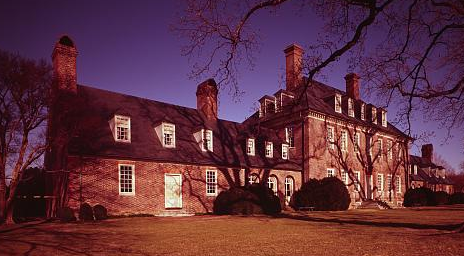Married: Lucy Ludwell Grymes at Brandon on January 16, 1738

Source: Colonial Williamsburg, Virginia Gazette (Parks) (January 6, 1738)
Died: January 3, 1777 at "Carters Grove" in James City County1
Born: October 25, 1716 at "Fairfield" in Gloucester County
Married: Lucy Ludwell Grymes at Brandon on January 16, 1738

Source: Colonial Williamsburg, Virginia Gazette (Parks) (January 6, 1738)
Died: January 3, 1777 at "Carters Grove" in James City County1
Parents: Nathaniel Bacon Burwell and Elizabeth Carter
Children:
Lucy Burwell
Elizabeth Burwell
Judith Burwell
Alice Burwell
Sarah Burwell
Mary Burwell
Nathaniel Burwell
Carter Burwell
Lewis Burwell
Carter Burwell used his inherited wealth, local craftsmen, and slave labor to build a mansion home near Williamsburg between 1749-1756. It was located on a parcel called Carter's Grove, a named required by the will of Burwell's grandfather Robert "King" Carter.2
The interior woodwork was done by Richard Baylis, who came from England. It was built to impress visitors with the wealth and power of the owners:3
In 1907, the kitchen was connected to the main house. Other major alterations to the original structure occurred in 1928, when the dependencies were also connected to the main house and the roof was raised to add a third floor.4 The Colonial Williamsburg Foundation acquired Carters Grove by donation in the 1960's. In the 1970's archeologists discovered and then excavated Wolstenholme Towne, a fortified settlement at Martin's Hundred that was destroyed in the 1622 uprising led by Opechancanough. Visitors could explore a museum constructed underground so it would not dominate the historic Wolstenholme Towne setting, plus learn about the living conditions in the 1750's from costumed interpreters at a reconstructed slave quarter. The mansion house itself was not restored to the colonial era of Carter Burwell and Lucy Ludwell Grymes; instead, it was decorated and interpreted as a Colonial Revival house of the early 20th Century.5 The foundation closed the property to visitation in 2003, then sold the property with in 2007. The sale of such an historic asset was controversial, but the cost of maintaining the facility was high. The revenue generated by visitors was low, in part because it was almost 10 miles away from the center of the restored buildings on Duke of Gloucester Street in Williamsburg. To protect the historic value of the property after its return to private ownership, the Colonial Williamsburg Foundation deed included conservation easements co-held by the Virginia Outdoors Foundation and the Virginia Department of Historic Resources. Controversy was renewed after the buyer, Halsey Minor, defaulted and the house fell into disrepair. The foundation repurchased Carters Grove at a bankruptcy sale, repaired it, then re-sold it again in 2014.6 |
 Carter's Grove was built by Carter Burwell after he married Lucy Ludwell Grymes, then expanded in 1907 and 1928 to its current size Source: Library of Congress, Exterior view - Carter's Grove, U.S. Route 60 vicinity, Williamsburg, Williamsburg, VA |
References
1. "Carter Burwell, of The Grove, near Williamsburg," Geni, https://www.geni.com/people/Carter-Burwell-of-The-Grove-near-Williamsburg/6000000001180223284 (last checked March 20, 2016)
2. "While court battles rage, Carter's Grove suffers," The Virginian-Pilot, March 25, 2012, http://pilotonline.com/life/while-court-battles-rage-carter-s-grove-suffers/article_60451a3a-4a99-597b-9b48-39879af30570.html (last checked March 20, 2016)
3. "Colonial Williamsburg sells Carterís Grove Plantation after bankruptcy," Washington Post, September 19, 2014, https://www.washingtonpost.com/local/colonial-williamsburg-sells-carters-grove-plantation-after-bankruptcy/2014/09/19/ebe79418-403b-11e4-b0ea-8141703bbf6f_story.html (last checked March 20, 2016)
4. "Carter's Grove, U.S. Route 60 vicinity, Williamsburg, Williamsburg, VA," Historic American Buildings Survey, HABS VA,48-WIL.V,1- (sheet 1 of 27), http://hdl.loc.gov/loc.pnp/hhh.va0654/sheet.00001a (last checked March 20, 2016)
5. "Carter's Grove," post on The Devoted Classicist blog, John J. Tackett, June 12, 2012, http://tdclassicist.blogspot.com/2012/06/carters-grove.html; "Slave Quarter at Carter's Grove," Colonial Williamsburg, http://www.history.org/almanack/places/hb/hbslave.cfm (last checked March 20, 2016)
6. "Colonial Williamsburg sells Carterís Grove Plantation after bankruptcy," Washington Post, September 19, 2014, https://www.washingtonpost.com/local/colonial-williamsburg-sells-carters-grove-plantation-after-bankruptcy/2014/09/19/ebe79418-403b-11e4-b0ea-8141703bbf6f_story.html; "Update: Colonial Williamsburg Landmark Carter's Grove Sold," National Trust for Historic Preservation, September 22, 2014, https://savingplaces.org/stories/colonial-williamsburg-landmark-carters-grove-sold/(last checked March 20, 2016)